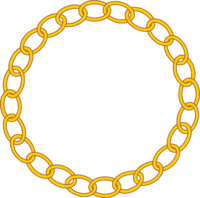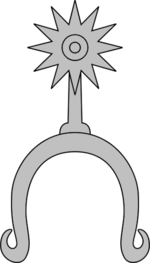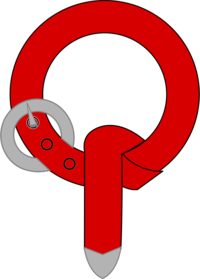| Heraldry | ||||||||||
|---|---|---|---|---|---|---|---|---|---|---|
 A white belt, symbol for the Order of Chivalry by Anita Challis, is licensed under CC BY-NC-SA 4.0 | ||||||||||
| Award Information | ||||||||||
|
Who They Are
The Order of Chivalry is a Society-wide order that is awarded for excellence in armored combat. It is one of the four major Bestowed Peerages and bestows a Patent of Arms [3].
Members of the Chivalry are outstanding fighters who have received recognition for their fighting skills, and they strive to be the very models of courtesy and chivalry. The Crown creates a Knight after consultation with the Order.
The Chivalry consists of two equal parts: Knighthood and Mastery of Arms. When a member is admitted to the Chivalry, the peer chooses which part of the order to join. To become a Knight, the candidate must swear fealty to the Crown of Atenveldt during the knighting ceremony. Masters-of-Arms may choose to swear fealty, but are not required to do so[4]
As it is an accolade recognized throughout the Society, any knights, or masters-at-arms, who move into Atenveldt are welcomed as equal members of the Order of Chivalry in Atenveldt[5].
Regalia
The SCA College of heralds reserves the following badge/regalia for the Chivalry[6]:
- (Fieldless) A white belt (for the Order of Knighthood)
- (Tinctureless) A circular chain (for the Order of Knighthood)
- (Fieldless) A white baldric (for the Order of Mastery at Arms)
In addition, the "Sumptuary Traditions and Guidelines of the Kingdom of Atenveldt"[7], allows Knights and Masters-at-Arms to wear the following:
Belts - White Belts are reserved for the exclusive use of the Knights. White Baldrics are reserved for the exclusive use of the Masters and Mistresses at Arms.
Chains of Fealty - symbolize a bond of Fealty between a member of the Chivalry and the Crown of Atenveldt. This includes Knights, who by virtue of their station must swear fealty to the Crown, and Masters-at-Arms who have chosen to swear fealty to the Crown. Chains of Fealty worn by the Chivalry should be plain gold or silver chains with links of sufficient size and style for the Crown to recognize them as such.
Spurs - The wearing and use of spurs (brass, silver, etc.) is restricted to members of the Chivalry.
Titles
Members of this Order are addressed as “Sir”, note that most women who are members of the order have chosen to use "Sir" (but can use another title). Masters-at-Arms are addressed as “Master” or “Mistress.” However the SCA has alternative titles[8] that may fit their persona's culture or persona.
Peerage Qualities
Peerages are the highest level of award given in the SCA and they recognize outstanding service to the Kingdom or expertise in a particular area. However a peer is more than that, they have to show qualities worthy of the title of peer – such as courtesy and respect to others, be passionate about sharing their knowledge, and play a significant role in our community. In short, be the kind of person we want to admire. SCA Corpora.[9] outlines these traits as follows:
The Candidates for any order conferring a Patent of Arms must meet the following minimum criteria. Additional requirements may be set by law and custom of the kingdoms as deemed appropriate and necessary by the Crown
- They shall have been obedient to the governing documents of the Society and the laws of the kingdom.
- They shall have consistently shown respect for the Crown of the kingdom.
- They shall have set an example of courteous and noble behavior suitable to a peer of the realm.
- They shall have demonstrated support for the aims and ideals of the Society by being as authentic in dress, equipment and behavior as is within their power.
- They shall have shared their knowledge and skills with others.
- They shall have practiced hospitality according to their means and as appropriate to the circumstances.
- They shall have made every effort to learn and practice those skills desirable at and worthy of a civilized court. To this end they should have some knowledge of a wide range of period forms, including but not limited to literature, dancing, music, heraldry, and chess, and they should have some familiarity with combat as practiced in the Society.
- They should participate in Society recreations of several aspects of the culture of the Middle Ages and Renaissance.
Each candidate for a patent order must satisfy the general requirements listed above, as well as the specific requirements listed here
Responsibilities
The Chivalry consists of two equal parts: Knighthood and Mastery of Arms. No one may belong to both parts of the order at one time. When a member is admitted to the Chivalry by the Sovereign, the choice of which part of the order to join is made by the new member. The candidate must be considered the equal of his or her prospective peers with the basic weapons of tournament combat. To become a Knight, the candidate must swear fealty to the Crown of his or her kingdom during the knighting ceremony. Masters-of-Arms may choose to swear fealty, but are not required to do so.[4]
The duties of the Chivalry are as follows:
- To set an example of courtesy and chivalrous conduct on and off the field of honor.
- To respect the Crown of the kingdom; to support and uphold the laws of the kingdom and Corpora.
- To enrich the kingdom by sharing his or her knowledge and skills.
- To support and uphold the Crown of his or her kingdom.
- To enhance the renown and defend the honor of the peer’s Lady or Lord.
- To advise the Crown on the advancement of candidates for the Chivalry.
- To bestow the Accolade of Knighthood upon a candidate for the Order of Knighthood, by sole right as both Sovereign and knight, or acting directly for a Sovereign who is not a knight.
Associations
All members of the Chivalry are entitled to take associates. They are known as "squires" and this title is used throughout the SCA to denote this relationship. The Cunnan wiki[10] has a basic definition of a "squire" in the SCA, however the role means many things to many people - so do your research and talk to peers before you commit to 'taking a belt'.
Atenveldt Sumptuary Laws[7] allow squires the exclusive use of red belts to show their association and squires to Masters-at-Arms have the exclusive use of red baldricks.
Ceremonies & Vigils
References
- ↑ "First Coronetting and Coronet Tourney Principality of Atenveldt AS.4", History of the Kingdom of the West, accessed 12/26/20
- ↑ "Past Royalty of the West Kingdom", History of the Kingdom of the West
- ↑ "Order of Chivalry" by Ginevra Fiammetta di Silvestri of Kingdom of Atlantia
- ↑ 4.0 4.1 “Section VIII.A.4.a "Patent Orders - The Chivalry" The Corpora of the SCA, SCA Inc., 19 Oct. 2019, www.sca.org/wp-content/uploads/2019/12/govdocs.pdf.
- ↑ Lachlan of Cromarty. “Chivalry.” Chivalry - Compendum Caidis, Kingdom of Caid, SCA Inc., 6 Mar. 2010, caidwiki.org/index.php?title=Chivalry.
- ↑ “Glossary of Terms - Table 1 Reserved Regalia.” SCA Inc. College of Arms Glossary of Terms, December 23, 2003, College of Arms for the Society of Creative Anachronism, Nov. 2019, heraldry.sca.org/coagloss.html
- ↑ 7.0 7.1 Kingdom Seneschal. “Sumptuary Traditions and Guidelines of the Kingdom of Atenveldt.” , Kingdom of Atenveldt, SCA Inc, 1 May 2018, docs.google.com/document/d/114dEXuQtmK0YujX0bTf9W5CEtlhGFcZSR0B7XtvqEoc/edit.
- ↑ “The List of Alternate Titles as Approved by the SCA College of Arms.” Society for Creative Anachronism, Inc., Nov. 2019, heraldry.sca.org/titles.html. Titles from different languages/cultures. Good for all titles within the SCA (AoA, Peers,Royalty)
- ↑ Section VIII.A.1 "Patent of Arms - General Requirements" The Corpora of the SCA, SCA Inc., 19 Oct. 2019, www.sca.org/wp-content/uploads/2019/12/govdocs.pdf.
- ↑ “Squire.” Edited by Paul Matisz, Cunnan, 11 July 2008, cunnan.lochac.sca.org/index.php/Squire. accessed 12/24/2020


